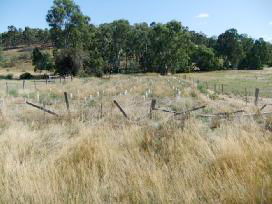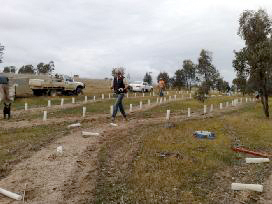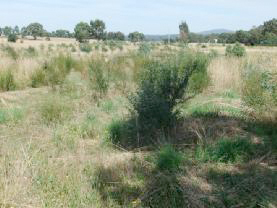
Nearmap image showing eastern part of project (2/2/10)
The purpose of this project is to provide a link between quality roadside vegetation in Turners Lane to the riparian zone of Chinaman Creek by establishing a range of trees and shrubs along a treeless 800 metre section of Creasys Road. The project commenced in 2009 with the support of 4 adjoining landholders, NCCMA 2nd Generation funding, Mt Alexander Shire Council and the CFA. The roadside planting of over 35 species extends into private land to form a corridor up to 35 metres wide. Land adjoining Turners Lane was also planted where an old direct seeding project had limited success.
Good soil preparation made planting out the 6,000 or so plants relatively easy, but the intimidating task of guarding was tackled by a marvellous group of dedicated volunteers. Because site preparation included rigorous rabbit control measures (spray and remove blackberry, fumigate and destroy warrens) there is very little evidence of predation. We have systematically removed some tree guards but with rapid growth in recent months the remaining plants now need liberating. These guards are being stockpiled for reuse in future planting projects.


The images above show the middle of the project area 6 months after planting (top) and at 18 months (below). The Black Wattles in the Creasys Road verge are now at least 2 metres tall. Eucalypts are just emerging above the tall Phalaris and Spear Grass.


Images were taken Feb 2010 (top) and Feb 2011 (below). The east area has been netted to keep out rabbits so the 2,000 plants did not need guarding. This zone has a mix of local species and a few interlopers such as Flooded Gum (Eucalyptus grandis). These have performed remarkably well tolerating frost, dry spells and inundation and their growth rates have exceeded the other plants in this area.


The connection to Chinaman Creek is predominantly Silver Wattle, River Red Gum and Bursaria. Plantings in the creek flat survived recent flooding which took out fencing but conveniently flattened the 2m high thistles!


Images taken Feb 10 (top) and Feb 11 (below). Turners Lane cnr Creasys Road – images taken on 13/9/09 (left) and 2/2/11 (right). The soil in this elevated area had no structure – it was like damp talcum powder – and although growth rates are relatively slow the majority of plants have survived. There is competition for moisture from the mature Grey Box in Turners Lane.


Image at top taken 2/2/11 from eastern extent of project looking west; image below is the same area during the burning of target sprayed Phalaris around the dam on 1/8/09.
Chemical use was limited to spraying of Blackberry, St Johns Wort and Phalaris stands near the existing dam.
During winter we burnt the dead patches of Blackberry, then fumigated and collapsed the exposed rabbit warrens during the following weeks. The control of weeds within planting strips was achieved by cultivation prior to planting in spring. Cultivation at this time also helps to warm up soil which facilitates root growth in the new plantings. We minimised chemical use to preserve soil bacteria and microorganisms.
Growth and establishment rates have varied over the project area. Some areas were too rocky to prepare and plant out. Plant mortalities occurred in a poorly drained area of heavy clay between the dam and Creasys Road and a patch within the Chinaman Creek connection where there may have been an old sheep dip. Over recent months the constantly wet soil conditions killed some established plants; Hedge Wattle (Acacia paradoxa) was affected, while Woolly Tea-tree (Leptospermum lanigerum) has coped well with both dry and wet sites. Using a wide range of species in the project has assisted the plant survival rates.
Overall plant mortality has been estimated at less than 5% which is remarkable given that we did not water in at planting time. The plants have been wholly dependent on rainfall. Ripping allowed plant roots access to moisture deep in the soil profile and the cultivation helped root establishment. This soil preparation also sped up the planting process – vigorous hiko stock was planted with a Pottiputki at a leisurely rate of around 1,000/day per person.
It is exciting to see this previously exposed and uninviting area being transformed. We look forward to seeing more bird and insect life – already Stubble Quail and a number of small birds have been spotted!

















